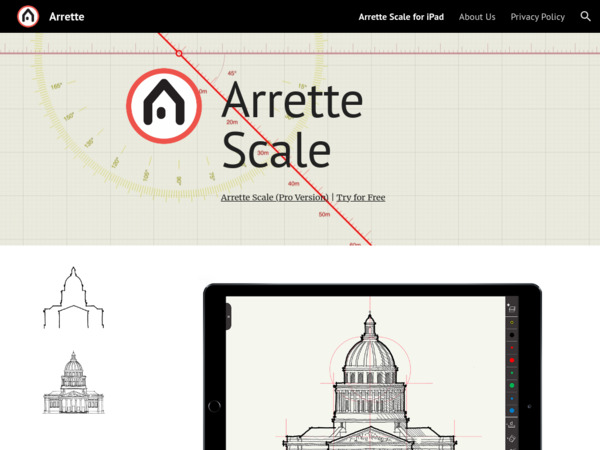Arrette Scale

Arrette Scale is a sketching / freehand drawing app for iPad. It’s built so you can draw with your usual style (pens or Apple Pencil), but keep everything at a measurable scale. You can import base images (maps, photos), work with layers, measure distances or areas, mark up drawings, switch scale systems, and export/share in standard formats (PDF, JPG, PNG).
How Architects Use It
- Start with site photos or maps, import them as base layers, then sketch design ideas or overlays to test spatial relationships or site constraints.
- Use the scale grid and measurement tools early on to check things like area, setback, circulation distances, or height sketches, so that your early visual explorations stay realistic.
- Layer different ideas (layouts, facade options, circulation paths) without losing earlier versions, compare visually, variate without redoing from scratch.
- Annotate or mark up drawings on the go—site visits, meetings, client presentations—so you can capture ideas, corrections, feedback immediately with scaled context.
- Quickly share sketches with clients or consultants to communicate intent, give visual feedback, or test iterations, while still preserving scale accuracy.
Strengths
- Maintains accurate scale from the beginning, helping ensure that sketches have real-world meaning, not just visual ideas.
- Intuitive and familiar drawing tools (freehand, ruler/protractor “Edge,” straight/arc modes) that don’t force users to give up their sketching style.
- Good base image import options (Photos, Maps, Dropbox, Adobe Creative Cloud) so you can work over real site info or earlier stages.
- Layers allow iteration and exploration of multiple ideas without losing earlier thinking. Helps keep design exploration flexible.
- Export in useful formats (PDF, PNG, JPG etc.), plus shareability, which aids communication with clients or integrating with other tools.
Things to Watch
- It’s iPad-only; so if you’re working mostly on desktop or need high-powered CAD/BIM features, you’ll need to move sketches out into those tools at some point.
- While scale is supported, technical drafting, complex construction documentation, or parametric modeling are outside its scope. It helps early/mid sketching, not final blueprints.
- Precision depends on input device (stylus, screen size/resolution). Fine detail work or annotations may be harder in very small or crowded drawings.
- Managing many layers or very complex imported base images could affect app performance or usability.
- Exported sketches may need adaptation to integrate into more technical tools (CAD/BIM) for documentation or detailed collaboration.
Why It Matters for Architects
Arrette Scale helps bridge a gap many architects face: how to retain real-scale information and measurable accuracy from the earliest sketches, while still sketching freely, visually, and fluidly. Because you can start with scale, overlay site or map data, iterate ideas, and share visual work immediately, it reduces the risk of “design drift” (ideas that look good but turn out impractical). It supports creativity, but keeps design tied to context—site, client constraints, measurements—so later phases go more smoothly.